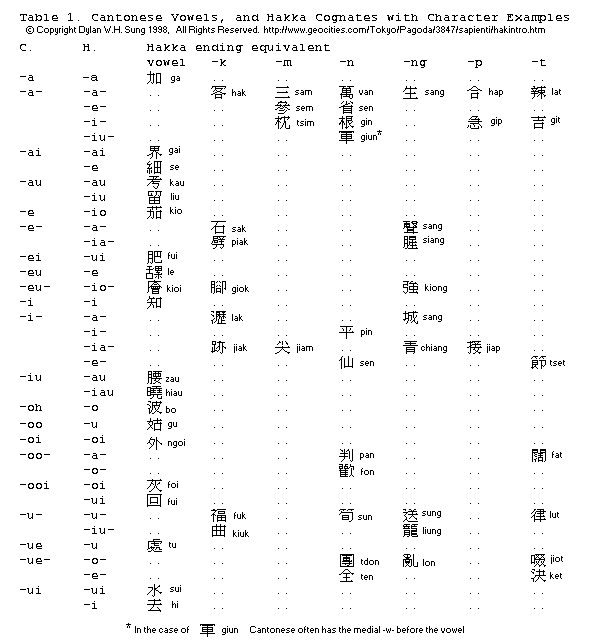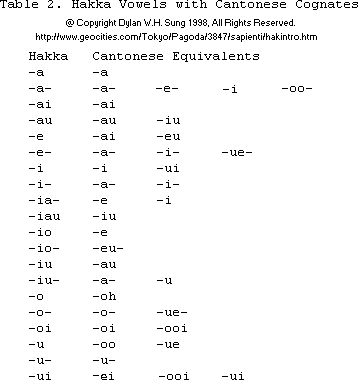
Introduction
There have been much said about the similarity of sounds between Cantonese and Hakka. Indeed, they have both been collectively known as Southern Chinese. They share the common features of preserving all the six classes of vowel type endings, -p, -t, -k, -m, -n, and -ng., whereas in Standard Mandarin, Putonghua, only the latter three consonant type endings are extant.
In this work, we shall compare Cantonese and Hakka vowels, first by noting all the endings found in Cantonese, and comparing them to Hakka. From these endings, we can extract the vowels to investigate.
I have looked up the words from Roy T. Cowle's "Pocket Dictionary of Cantonese".
Cantonese and Hakka Endings
The following 53 Cantonese endings are in Meyer Wempe romanisation and are as follows,
Cantonese Ending Inventory
a aai aak aam aan aang aap aat
aau ai ak am an ang ap at
au e ei ek eng eu euk eung
i ik im in ing ip it iu
o oh oi ok om on ong op
ot oo ooi oon oot ue uen uet
ui uk un ung ut
The 47 Hakka endings as found within this site are in SaTdiuGok Romanisation. They are:
SaTdiuGok Hakka Ending Inventory
a ai ak am an ang ap at
au e em en ep et i ia
iak iam iang iao iap im in io
ioi iok ion iong iot ip it iu
iuk iun iung o oi ok on ong
ot u ui uk un ung ut
(Please note that they are NOT table to table comparisons. They have be pre-formatted this way so that they do not take up too wide a space.)
We shall split up the sounds into three parts, Initial, Vowel, and Ending, where only the vowels will be of interest here. The initials and endings shall not be discussed, but made use of for demonstrating character examples.
Cantonese and Hakka Vowel Comparisons
We shall compare the sounds of Cantonese and try to establish their equivalent relationships in Hakka. Below is a table of the relations found between the two dialects, sorted by the type of endings horizontally, and by the various vowel and equivalent in Hakka.

Although the sounds of Cantonese are thus represented, it is hoped that they are clear enough to the reader as to their values. Hakka sound values can be found here. For the word C. /leu1/, H. /le2/  , it is a Southern dialectal character, but there is no equivalent in Big5, so it has been created here, though it can be represented seperately as two characters, the 'tongue' radical and the Mandarin 'lei' character. It means "to dribble saliva" for those of you who are unfamiliar with it. Admittedly, this is one of only a few -eu Cantonese words. The other dialectal character shown here is C./geui/ or H. /kioi/, which is Southern dialectal for 'to be tired'.
, it is a Southern dialectal character, but there is no equivalent in Big5, so it has been created here, though it can be represented seperately as two characters, the 'tongue' radical and the Mandarin 'lei' character. It means "to dribble saliva" for those of you who are unfamiliar with it. Admittedly, this is one of only a few -eu Cantonese words. The other dialectal character shown here is C./geui/ or H. /kioi/, which is Southern dialectal for 'to be tired'.
Cantonese long vowels are represented by a double vowel cluster. However, in the case of -aa-, I have just shortened it to -a- without any detriment to the relative comparisons between Cantonese and Hakka. For listeners, the "aa" dipthong lasts minutely longer than the single "a" vowel. "oo" is homophonous with the sound "wu:". So, "-ooi" as in the 'ash' /fooi/ would sound as though /fwu:i/ or /fu:i/, where the colon : indicate the prolonging of the preceeding vowel sound.
Within the romanisation here for SaTdiuGok Hakka, there is no special distinction for long vowels, except where they appear in a word. If vowels occur as the last element at the end of a sound, it will have a long value. If it is before another vowel or consonant at the end of the sound, it is short.
Hakka vowel dipthongs
There are a number of vowel dipthongs in SaTdiuHok Hakka which can be derived from other Hakka dialects. Quite often, I have rationalised them to absorb a glide. For instance, the -e- vowel can be found to derive from Meixian (MX) -ia-, so, MX /siat5/ is STG /set5/, a homophone for the words 'snow' and 'colour'. Bound up in the -e- vowel is also a glide which is prefixed to the -e- as -ie-, which further represents that the link to -ia- through this change. So for 'moon' MX /ngiat6/ whilst STG /nget6/ or /ngiet6/ if the glide is fully represented. One further mapping of this sound is as follows; ian = en MX /mian2/ STG /men2/ 'cotton'. Let us gather up all the Hakka vowels and compare them to the Cantonese

Where the vowels are of similar values, character readings are often similar, given the difference in the tone contours of both dialects, making correlations possible. In fact, from Table 2, it becomes clear that certain Hakka sounds have only one type of mapping into Cantonese. For example, Hakka -io- will always have the Cantonese equiivalent -eu-, as witnessed by the examples given in Table 1.
The similarity of such the vowels in both dialects seems to add to the belief that Cantonese is indeed related to Hakka, albeit disantly.

You can e-mail me here on anything you like!